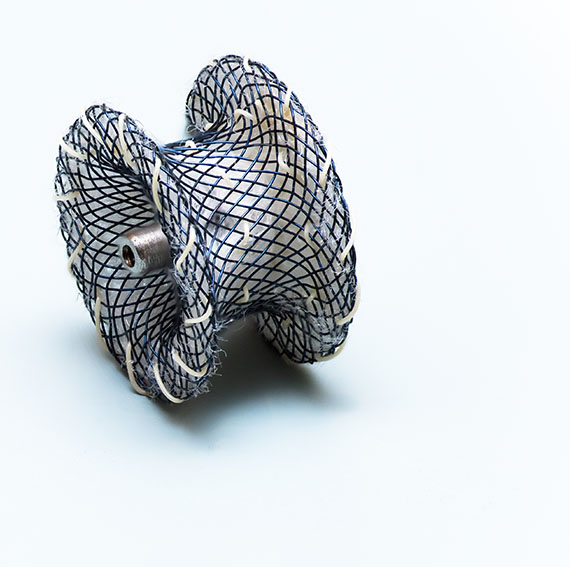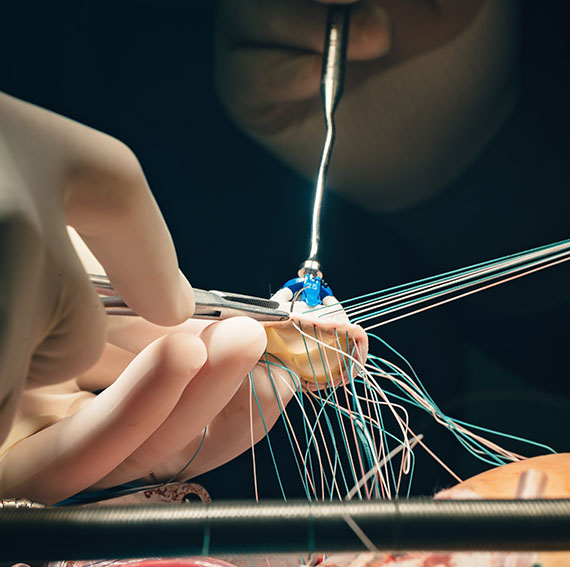Custom Structural Heart Valve Design and Manufacturing
Tricuspid, Pulmonary, Mitral & Aortic Valves: When the human heart valve becomes severely diseased and can no longer function adequately to pump and prevent leakage of blood, it may become necessary to replace one or more of those valves with an artificial version. Transcatheter valves require thin, compliant fabrics to meet the demands of today’s minimally invasive transcatheter procedures. Transcatheter valves often require fabrics to prevent paravalvular leakage (PVL) while maintaining a low profile design to support small delivery catheter requirements. Thin, low permeability woven fabrics are often used to achieve the desired requirements. Thin knit fabrics can also be used to support the elimination of PVL. While ATEX Technologies can provide flat tapes, tubular fabrics typically provide further improvements in assembly operations and can contribute to the reduction of PVL. Custom laser cut vascular or structural heart components can be provided that align the tricuspid, mitral and aortic valves with the valve frame geometry, further simplifying assembly operations.
Heart Valve skirt attachment via sutures can be challenging and time-consuming, especially when managing the lack of contrast between white UHMWPE sutures and white heart valve skirt components. ATEX Technologies’ can provide custom dyed UHMWPE using FDA-approved colorants, further simplifying the assembly process and by marking the points at which to sew through its fabric marking capabilities.
Left  Atrial Appendage Occlusion (LAAO) Devices: Atrial fibrillation can result in blood clots dislodging from the left atrial appendage, resulting stroke. LAAO devices are designed to prevent this from happening. Devices may block the opening of the appendage, or they may clip the appendage from outside of the left atrium. LAAO devices designed to block the opening of the appendage typically require thin fabric covering with significant flexibility and distinct pore size to achieve the desired result. The flexibility enables the device to crimp down for loading and deployment while maintaining a uniform covering of the LAAO device frame when fully deployed. The pore size is critical in order to allow blood flow across the device while preventing blood clots from dislodging from the appendage.
Atrial Appendage Occlusion (LAAO) Devices: Atrial fibrillation can result in blood clots dislodging from the left atrial appendage, resulting stroke. LAAO devices are designed to prevent this from happening. Devices may block the opening of the appendage, or they may clip the appendage from outside of the left atrium. LAAO devices designed to block the opening of the appendage typically require thin fabric covering with significant flexibility and distinct pore size to achieve the desired result. The flexibility enables the device to crimp down for loading and deployment while maintaining a uniform covering of the LAAO device frame when fully deployed. The pore size is critical in order to allow blood flow across the device while preventing blood clots from dislodging from the appendage.
 Aortic Valve Sewing Rings: When a heart valve is replaced with a surgical prosthetic, it must sit securely in place and be able to withstand the force of the beating heart as well as the passage of blood through the chambers. Surgeons rely upon the sewing ring encircling the surgical valve to accomplish these tasks. The sewing ring often consists of a PET knit mate
Aortic Valve Sewing Rings: When a heart valve is replaced with a surgical prosthetic, it must sit securely in place and be able to withstand the force of the beating heart as well as the passage of blood through the chambers. Surgeons rely upon the sewing ring encircling the surgical valve to accomplish these tasks. The sewing ring often consists of a PET knit mate